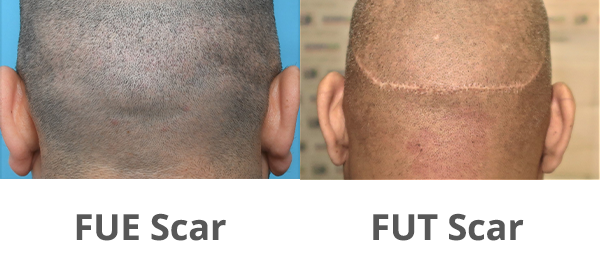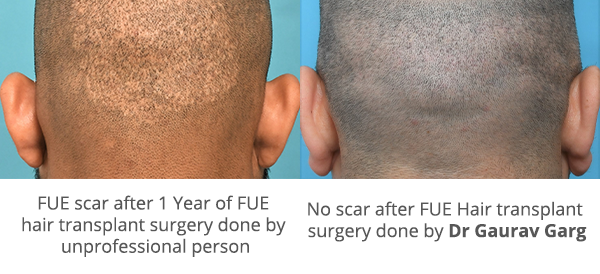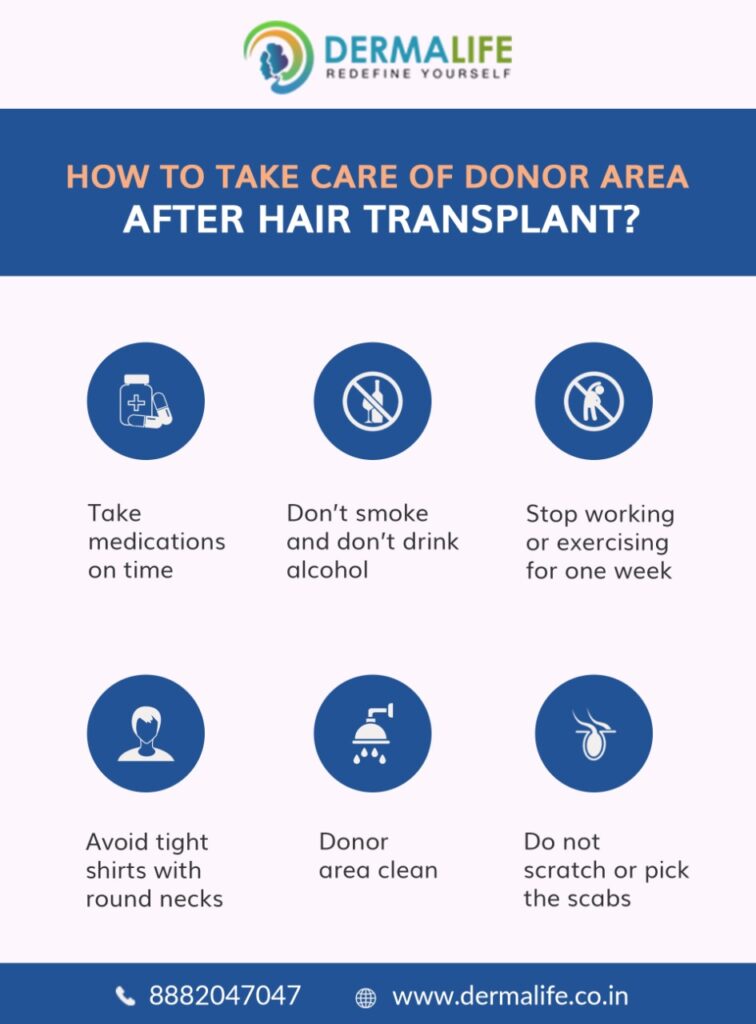Are you thinking about hair transplant surgery but worried and scared about the scars that it will leave behind? Do FUE hair transplant surgeries leave scars? Can a hair transplant surgery be a scarless procedure? Is Hair Transplant Scarring Noticeable?
If you have these questions in mind and you are looking for a truthful answer, the answer is all surgeries leave a scar, and a hair transplant surgery, whether a Follicular Unit Transplantation (FUT) or Follicular Unit Extraction (FUE) surgery, will leave behind scars. The good news is that a carefully planned FUE hair transplant in Delhi that is performed by an experienced and qualified surgeon will ensure that no or minimal scar is left visible to the naked eye. By choosing FUE over FUT, you can stay protected against the frightening linear scars associated with FUT procedures and can even make a quick return to normal activities.
Table Of Contents
Feel free to skip ahead if one topic catches your eye:
1. Hair Transplant Procedure and Scarring
2. Are hair transplant scars permanent?
3. How to Conceal Hair Transplant scars?
4. Can hair grow back after scarring?
5. Hair transplant scar removal Methods
Hair Transplant Procedure and Scarring
Follicular unit extraction (FUE) can be described as a minimally invasive hair restoration procedure in which individual hair grafts are extracted after administering anesthesia from the patient’s scalp area where there is still healthy and abundant growth and presence of hair by trimming an area on the patient’s head or around the scar.
The extracted hairs are then transferred to the balding or hair-thinning areas. During the procedure, the surgeon will employ small punches either 0.70mm or 0.8.mm for scoring the hair follicles to create openings in the donor area. Thereafter, hair follicles will be taken out from the donor area and then inserted or grafted into the bald area after creating very fine slits with the help of very fine CTS blades or needles. Once this procedure has been completed, the surgeon will bandage the donor area.
The FUE procedure usually lasts for 4 hours to 8 hours. The surgeon will recommend anti-inflammatory medications, pain-relieving medicines, and antibiotics so that patients don’t have to deal with pain, swelling, or inflammation. After the surgery, patients are advised not to engage in strenuous activities for 3-4 weeks and to abstain from medications such as ibuprofen (Advil) and Aspirin. The consumption of alcohol and nicotine is also not recommended for at least 2-4 weeks after a hair transplant in Delhi. The surgeon may recommend hair growth stimulants such as Finasteride (Propecia) or Minoxidil (Rogaine) to patients after the FUE procedure.
Unlike the FUT Hair Transplant in Delhi, the small incisions left behind from the removal of hair grafts are filled with scar tissues, and small “dot” scars are left behind. This is where the expertise of the surgeon comes into the picture.
There is another aspect to FUE hair transplant scars: the follicular unit extraction scarring underneath the skin surface and how it affects the remaining skin surface of the patient’s scalp. The human body activates an inflammatory response when it starts healing and creating a scar. During this response, all types of cells are sent by the body to the “damage site” in an unplanned manner to start the process of healing. This usually leads to a minimal amount of follicular unit extraction scarring after an FUE procedure.
There is no denying the fact that FUE hair transplant scars are real but it is equally true that these FUE hair transplant scars, on their own, are much less visible when patients opting for the FUE procedure decide to go for very short haircuts. If the hairs of the patient are kept long, FUE hair transplant scars are usually not visible. In other words, the size of FUE hair transplant scars is directly proportional to both the healing characteristics of the patient and the size of the FUE punches used by the hair transplant surgeon in Delhi.
As stated previously, every surgical procedure results in a scar, and FUE hair transplant scars are no exception. Thankfully, the concept of FUE hair transplant scars is relative. It is important to remember here that scar tissue is created every time the body undergoes some kind of trauma where wound healing and inflammation are involved. Even a bump on the head leaves behind scar tissues under the surface of our skin.
During an FUE procedure, there are two areas on the body where “incisions or cuts” are made:
- Incisions are made on the donor area during the process of graft removal.
- Incisions are also made on the bald or hair-thinning areas (the recipient sites) where new grafts are made.
When performed by an experienced and qualified hair transplant surgeon, FUE procedures usually don’t leave visible FUE hair transplant scars. Of course, there will be some scarring beneath the skin but it will not be visible above the surface of the skin. The only time FUE hair transplant scars are visible in the recipient area is when large tools or incisions are made or if the hair transplant clinic or hospital places an inappropriate count of hair grafts too close together resulting in tissue damage. It is for this reason that you should only place your trust in the hands of a reputed and experienced hair transplant surgeon. The good news is that FUE hair transplant scars are rare to locate, very minimal, and hidden below the patient’s hair.
Why Choose FUE over FUT?
FUE is the gold standard of hair transplantation across the globe these days and for obvious reasons. FUE hair transplants are ideal for everyone who doesn’t want noticeable scars. It is worthwhile to note here that FUT procedures leave a linear scar that may be seen by the naked eye. Moreover, FUT hair transplants are characterized by more pain, swelling, and discomfort and patients have to undergo a longer healing time and stitches.
In FUE procedures, patients don’t experience numbness and nerve damage that may be risks with FUT procedures.

Are hair transplant scars permanent?
One of the biggest advantages of FUE procedures is that it is extremely easy to conceal the scars. Since the follicular unit extraction scarring is very small (0.7mm-0.9mm), it can be easily concealed by the surrounding hair. FUE patients need to remember that they should not cut their hair down to a grade 1 or 2 (leaving only a thin hair layer on the scalp; almost bald but just not bald). With FUE procedures, there are no linear scars, unlike FUT procedures.
How to Conceal Hair Transplant Scars?
The extent to which FUE hair transplant scars can be concealed depends on many factors. This includes factors, including but not limited to the scar texture, the surrounding skin, the extent to which the scar area has healed, the size of the scar, the width and position, the appearance (flat, raised, or indented) of the scar, the skills of the surgeon, the count of hair that are surrounding the area, the shape of the head, the healing characteristics of the patient, etc.
FUE patients can opt for concealing the scarred area cosmetically. For this, they may simply opt for growing hair over the donor area. Some patients even opt for temporary concealers to make their hair appear voluminous and thicker while hiding FUE hair transplant scars under their hair.

Can hair grow back after scarring?
Generally, hair does not grow in scar tissues as there is an absence of hair follicles in a scar. However, you can surely get a hair transplant on the scar tissue. For this, the surgeon will proceed with grafting hairs that are still present in the follicles into the scar.
This will allow the hair to start taking roots and then they will grow again once a connection with blood vessels is made. In other words, hair follicles will generally start growing hair back for an FUE patient after the area has been completely healed and the follicles are fully grafted by the surgeon into the skin to receive the supply and flow of blood from nearby blood vessels.
Hair transplant scar removal methods
There are many types of hair transplant scar removal methods:
- Laser treatment: Laser treatment can help in minimizing the appearance of FUE hair transplant scars and is usually used in conjunction with Tricopigmentation (TMP) and Scalp micropigmentation (SMP). During this procedure, damaged skin on the scar surface is targeted by the laser. The laser treatment is also helpful for stimulating the production of collagen in the dermis layer of the skin. This, in turn, rejuvenates the overall appearance and elasticity of the patient’s skin.
- Scalp micropigmentation (SMP): Also referred to as scalp hair tattooing or medical hairline tattoo, Scalp micropigmentation is all about injecting pigments directly into the patient’s scalp to offer the appearance of thicker and voluminous hair. Scalp micro pigmentation may be used to color in the scarred areas left behind by FUE hair transplant scars. It is important to remember here that patients may need to attend multiple SMP sessions to experience noticeable effects, depending on the scalp area being injected.
- Tricopigmentation (TMP): Tricopigmentation can be described as a temporary form of Scalp micropigmentation. It is a procedure with which patients can expect semi-permanent inking as it inserts the ink into the dermis’s top layer.

Takeaway
There is no denying the fact that follicular unit extraction (FUE) is one of the best procedures for hair restoration. The FUE procedure helps restore the appearance of a rich head of hair to restore self-confidence and self-esteem, and patients stop feeling disappointed with the way they look. However, follicular unit extraction scarring may scar some people but the good news is that the FUE hair transplant scars are almost invisible. It is one of the biggest reasons why people prefer FUE over FUT procedures as it helps them make a quick return back to normal activities.
Now comes the most important part, you need to select a qualified, experienced, and knowledgeable hair transplant surgeon and have a detailed consultation with them to gain a complete and clear understanding of the FUE procedure, the pros and cons of FUE hair transplants, the cost of FUE procedure, the number of grafts required, and how to manage FUE hair transplant scars. This consultation will help you get the peace of mind and understanding that you should have and rightly deserve before you undergo FUE surgery.
If you need help with FUE surgery from a qualified, experienced, and knowledgeable hair transplant surgeon, please feel free to get in touch with Dermalife, the best hair transplant clinic in Delhi NCR. Dermalife is the name that thousands of patients from different parts of the country and the world trust when it comes to hassle-free, safe, and affordable FUE hair transplants. The team of medical professionals has successfully performed thousands of FUE procedures and is globally renowned for its contributions to the world of hair transplants.
Call Dr. Gaurav Garg or Dermalife and experience a safe FUE hair transplant now!





